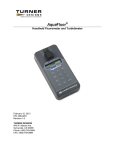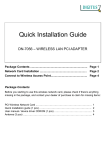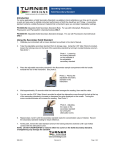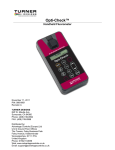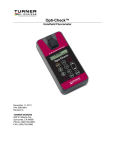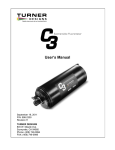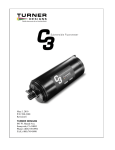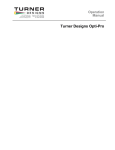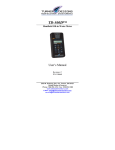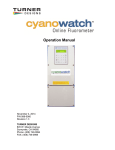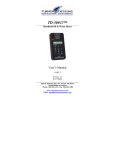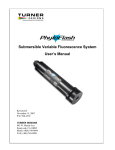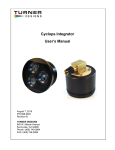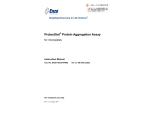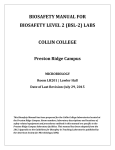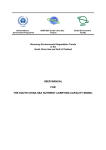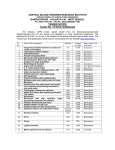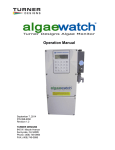Download Manual
Transcript
AquaFluor™ Handheld Fluorometer and Turbidimeter May 4, 2011 P/N: 998-0851 Revision 1.4 TURNER DESIGNS 845 W. Maude Ave. Sunnyvale, CA 94085 Phone: (408) 749-0994 FAX: (408) 749-0998 Table of Contents 1. Introduction 1.1 Description 1.2 Quick View Diagram 1.3 Inspection and Setup 1.4 General Information, Precautions & Cleaning 2. 3. 4 5 6 4 4 4 5 Instrument Specifications 2.1 General Specifications 2.2 Optical Configurations for Applications 2.3 Cuvette Information 2.4 Cuvette and Solid Standard Configurations for Application 6 6 7 7 Instrument Operation and Calibration 3.1 Instrument Power Up 3.2 Detection Channel Configuration 3.3 Calibration Overview 3.4 Calibration Procedure 3.5 Instructions for using the Adjustable Secondary Standard 3.6 Sample Analysis 3.7 Diagnostic Information 8 8 8 9 10 11 11 Data Transfer and Internal Data Logging (IDL) 4.1 Shipping Checklist 4.2 Hardware Requirements 4.3 Installation 4.4 Connecting 4.5 Real Time Data Transfer 4.6 Data Transfer Troubleshooting 4.7 Internal Data Logging (IDL) 12 12 12 12 12 13 13 Sample Analysis Guidelines 5.1 Handling Samples 5.2 Positioning Samples 5.3 Linear Range and Quenching 5.4 Temperature Considerations 5.5 Data Quality 14 14 14 15 15 Applications 6.1 In Vivo Chlorophyll 6.2 Extracted Chlorophyll a 6.3 Ammonium Detection 6.4 Turbidity 6.5 Fluorescent Tracer Dyes 6.6 Cyanobacteria Monitoring 6.7 CDOM 6.8 Optical Brighteners 6.9 PTSA 16 17 17 18 18 18 19 19 19 AquaFluor™ User’s Manual 2 Table of Contents cont. 7 8. Quick Diagnosis Guides 7.1 Power / Battery / Screen Issues 7.2 Reading and Calibration Issues 7.3 Recovery of a Lost Channel 7.4 Connection Issues 20 21 22 23 Warranty 8.1 Terms 8.2 Warranty Service 8.3 Out of Warranty Service 24 25 25 AquaFluor™ User’s Manual 3 1 Introduction 1.1 Description The AquaFluor™ is a lightweight, handheld fluorometer and turbidimeter. Its dual channel capability allows the user to measure either fluorescence or turbidity in one sample. The AquaFluor™ can be configured with any two channels as follows: in vivo Chlorophyll a, Extracted Chlorophyll a, Cyanobacteria (Phycocyanin or Phycoerythrin), Turbidity, Rhodamine WT, Fluorescein, Ammonium, CDOM, Optical Brighteners or PTSA. 1.2 Quick View Diagrams Battery panel O-ring 1.3 Inspection and Setup 1.3.1 Inspection Upon receiving your instrument, please inspect everything carefully and make sure all accessories are present. All shipments include: • • • • • The AquaFluor™ The User’s Manual on CD 4 - AAA batteries Cuvettes – Qty 4 Storage Pouch AquaFluor™ User’s Manual 4 1.3.2 Setup Before the AquaFluor™ can be used, the supplied batteries must be installed. 1. On the back side of the instrument, remove the battery panel by loosening the center screw and then gently pulling on the screw. There is some resistance due to the o-ring which is used for watertight sealing (see Section 1.2 for diagram). 2. Install the 4 - AAA batteries and verify the batteries are positioned correctly. 3. Replace the battery panel and press it down into position. 4. Hold the battery panel down in place and gently tighten the screw until it is snug. Do not over tighten the screw. Note: If the battery panel is very difficult to press down or remove, you can apply a small amount of silicon based o-ring grease to lubricate the o-ring as needed. 1.4 General Information, Precautions and Cleaning • • • • • • • • The sample compartment cannot accept 10 mm square glass or quartz cuvettes because the cuvette wall thickness exceeds the 12 mm maximum outer dimension that the AquaFluor™ can accept. The 10 mm size is the internal dimension of the cuvette and some plastic cuvettes may also be too large. Do not force oversized cuvettes into the sample compartment. This can damage the sample compartment. If the cuvette does not easily fit down inside the AquaFluor™ you will need to purchase different cuvettes. Round glass test tubes can be used with an optional adapter that is available. Refer to Section 2.3 for cuvette information. Use caution around solvents because they may attack the plastic case of the AquaFluor™. If a sample is accidentally spilled inside the Sample Compartment, invert the AquaFluor™ to drain out the excess liquid. Then wipe the inside area dry with a clean soft towel or tissue. If extra cleaning is needed, use a mild detergent to dampen the towel for cleaning. Do not submerge the AquaFluor™ in water. Do not expose the AquaFluor™ to temperatures outside the specified range of 5 to 40 °C or damage may occur to the unit that wil l not be covered under warranty. AquaFluor™ User’s Manual 5 2 Instrument Specifications 2.1 General Specifications Specification Size Weight Dynamic range Resolution LCD Display Case Temperature Detector Calibration Type Error message Cuvette Type Warm Up Time Auto Power Off Description 1.75” x 3.5” x 7.25” (4.45cm x 8.9cm x 18.4cm) 13.9oz (0.4kg) 3 orders of magnitude 12 bits 2 x 16 characters Meets IP 67 Standard; dustproof and waterproof 41-104 °F; 5-40 °C Photodiode Single-point and blank Low battery, High blank See Section 2.3 5 seconds After 3 minutes of inactivity 2.2 Optical Configurations for Application (Channel) Application Light Source Minimum Detection Limit Linear Range Excitation Emission Temperature Coefficients Ammonium (NH4) UV LED 0.1 µM 0 - 100 µM 350 nm 430/30 nm Not Available CDOM UV LED 0.1 ppb 0 - 1000 ppb 350 nm 430/30 nm Not Available Chl a Extracted - Acidification Blue LED 0.5 µg/L 0 - 300 µg/L 430 nm 685 nm 0.3/°C Linear Chl a in vivo Blue LED 0.3 µg/L 0 - 300 µg/L 430 nm >665 nm 1.4%/oC Linear Fluorescein Dye Blue LED 0.4 ppb 0 - 400 ppb 485 nm 540 nm 0.0036/°C Exponential Optical Brighteners UV LED 0.5 ppm 0 - 30,000 ppm 350 nm 440/15 nm Not Available Yellow LED 150 cells/ml 0 - 150,000 cells/ml 590 nm 670/80 nm Not Available Green LED 150 cells/ml 0 - 150,000 cells/ml 540 nm 575/35 nm Not Available Rhodamine Dye Green LED 0.4 ppb 0 - 400 ppb 550 nm >570 nm 0.026/°C Exponential Turbidity Green LED 0.5 NTU 0 - 1000 NTU 515 nm 515 nm Not Available PTSA UV LED < 1 ppb 0 – 1000 ppb 365 nm 400 nm -0.00126/°C Exponential Phycocyanin (Freshwater Cyanobacteria) Phycoerythrin (Marine Cyanobacteria) AquaFluor™ User’s Manual 6 2.3 Cuvette information Cuvette type Size Usage Part No. Methacrylate plastic 10 mm Square (height 44.5 mm) Required for UV (< 400 nm), works for all applications. Do NOT use with solvents (ie. Acetone) 7000-959 Polystyrene Plastic 10 mm Square (height 47.5 mm) Preferred for Turbidity use, will NOT work for UV. Do NOT use with solvents (ie. Acetone) 7000-957 Borosilicate glass 12 x 75mm Round Required for Extracted Chlorophyll where solvents are used. Requires Adapter PN 8000-932 10-029A Minicells – Borosilicate Glass 5 x 31mm Flat bottom Minicells for use with high concentration samples. Requires Adapter PN 8000-936 (200 µL capacity) 7000-950 2.4 Cuvette and Solid Standard Configurations for Application Application Ammonium CDOM Sol. Std. Not Available Not Available 10x10 mm Cuvettes 12 mm Vials Methacrylate Glass Methacrylate Glass Chl a Extracted - Acidification 8000-952 N/A Glass Chl a in vivo 8000-952 Methacrylate or Polystyrene Glass Fluorescein Dye 8000-951 Methacrylate or Polystyrene Glass Optical Brighteners Not Available Methacrylate Glass Phycocyanin (Freshwater Cyanobacteria) 8000-951 Methacrylate or Polystyrene Glass Phycoerythrin (Marine Cyanobacteria) 8000-952 Methacrylate or Polystyrene Glass Rhodamine Dye 8000-952 Methacrylate or Polystyrene Glass Turbidity Not Available Not Available Methacrylate or Polystyrene Glass Methacrylate Glass PTSA AquaFluor™ User’s Manual 7 3 Instrument Operation and Calibration 3.1 Instrument Power Up To turn on the AquaFluor™, press the <ON/OFF> button. After a 5 second warm up, the AquaFluor™ is ready for operation. Pressing the <ON/OFF> button again will turn the unit off or if left idle for 3 minutes the unit will turn itself off to save battery power. A set of new batteries will last for over 1,000 sample readings. If the batteries have low power or are not positioned properly, the following warning message will be displayed – “Batt Level < 20% !! Caution !!”. The contrast of the display can change with temperature and will get lighter as the unit gets colder. The contrast can be easily adjusted. Press the ↑ arrow button to darken the contrast and press the ↓ arrow to lighten the display contrast. 3.2 Detection Channel Configuration The AquaFluor™ can be configured with one or two optical channels. To identify the configuration look at the label on the back side of the AquaFluor™. The <A/B> button allows the user to toggle between the 2 channels. The display will show a label in the lower left corner of the Home screen to identify which channel is activated. 3.3 Calibration Overview The AquaFluor™ can be calibrated using a Primary standard. A Primary Standard is one that contains the same fluorescent material that you are measuring in your unknown samples. The AquaFluor™ will give an actual quantitative concentration reading when a primary standard of known concentration is used for calibration. The standard and samples must be in the linear detection range to get accurate quantitative results. Refer to Section 5.3 for more details about the linear range and quenching of the samples. For Dye tracing applications the calibration is normally performed with a primary standard made from the same dye that is being used for the testing. The primary standard will either be made to a known concentration, typically in ppb or µg/L units, or to a known dilution factor. Ideally the Primary Standard and Blank samples used for calibrating will be made with the same water the tests are being performed in. For more details on this and tracer dye use, please refer to the Turner Designs website under Application Notes for “A Practical Guide to Flow Measurement”, document 998-5000. AquaFluor™ User’s Manual 8 3.4 Calibration Procedure It is recommended for best accuracy, that you always calibrate before performing your sample analysis. The AquaFluor™ will save the calibration settings for each channel until a new calibration is performed. If the temperature of your samples or the AquaFluor™ changes significantly, the readings may show a small shift and in this case, you should consider recalibrating. The solid secondary standard is useful for checking the reading stability over time. Refer to section 3.5 instructions for using the solid secondary standard. The AquaFluor™ is designed with “ambient light rejection”. The black sample compartment cover does NOT need to be closed when calibrating or reading samples. This allows for the use of cuvettes with different height dimensions, such as the 12x75 mm round glass tubes. The orientation and cleanliness of the cuvettes can have an impact on the accuracy of your results. Refer to Section 5, Sample Analysis Guidelines for information to help ensure the best results for your analysis. 3.4.1 Assign a Calibration Standard Value. This defines the numeric value that you want the standard to read. For example, if you calibrate with a primary standard that has a concentration of 50 µg/L, then you will set the value to 50 and the implied unit of measure will be in µg/L. 3.4.1.1 Press the <STD VAL> button. 3.4.1.2 Use the ↑ and ↓ arrow buttons to set the standard value. Pressing the arrow button once quickly will make a small incremental change to the value. Holding either arrow button will allow you to change the value using fast scrolling. 3.4.1.3 When finished, Press the <ENT> or <ESC> button to accept the value and to return to the Home screen. 3.4.2 Perform the Calibration. 3.4.2.1 Press the <CAL> button. 3.4.2.1 Press <ENT> to start the calibration. 3.4.2.3 Insert your blank sample and press <ENT>. The AquaFluor™ will average the reading for 10 seconds and set the blanking zero point. 3.4.2.4 Insert the standard sample and press <ENT>. The reading is averaged for 10 seconds and the Standard Calibration value is set. 3.4.2.5 Press <ENT> when the calibration is complete to accept the calibration. If <ENT> is not pressed within 10 seconds, you will be asked if you want to abort the calibration. Press the ↑ or ↓ arrow button to abort or accept the calibration respectively. If at anytime during steps 1-4 you want to stop the calibration, press <ESC>. This will return you to the Home screen and will default the instrument to the previous calibration. AquaFluor™ User’s Manual 9 3.4.3 Calibration Check Once the AquaFluor™ calibration is accepted, press the <DIAG> button to see what your standard to blank ratio is. The standard to blank ratio is defined as the %FS blank as compared to the %FS standard. The %FS signal should be at least 5 times larger than the %FS Blank. It should be between 5 and 30. • If your %FS std:%FS blk ratio is greater than 30, dilute your Calibration Standard accordingly and recalibrate. Check the ratio again. • If your ratio is less than 5 you'll have to find a different standard for calibration. • If your ratio falls between 5 and 30 after the initial calibration then you can start measuring samples. 3.5 Instructions for using the Adjustable Secondary Standard. For some applications a Secondary Standard is available to track calibrations over time. A secondary standard is one that contains a different type of fluorescent material than your samples. Please refer to section 2.4 for the solid standard configuration for your application. 3.5.1 When a Secondary Standard is used, the AquaFluor™ will give relative sample readings that are proportional to the measured fluorescence. In some cases these relative sample readings will be correlated back to actual concentrations that are determined later. 3.5.1.1 Calibrate the AquaFluor™ with a solution of known concentration per section 3.4. 3.5.1.2 Take the adjustable secondary standard from its storage case. Using the 0.05” Allen Wrench provided, loosen the locking screw on the back of the secondary standard by turning it counterclockwise one turn. (See photo 1) Photo 1. Loosening the locking setscrew on the backside of the adjustable secondary standard 3.5.1.3 Place the adjustable secondary standard in the fluorometer sample compartment with the handle towards the rear of the instrument. (See photo 2). Photo 2. Placing the adjustable secondary standard in the AquaFluor™ 3.5.1.4 Close the lid 3.5.1.5 Wait 15 seconds, then read the value. 3.5.1.6 Record the value of the secondary standard. AquaFluor™ User’s Manual 10 3.5.1.7 Open the lid, and use the 3/32” Allen Wrench provided to adjust the attenuation screw through the hole at the top of the secondary standard to increase or decrease the value displayed on the screen. (Turning the screw counterclockwise will increase the reading). (See Photo 3) Photo 3. Adjusting the value on the secondary standard by turning the attenuation screw. 3.5.1.8 Repeat steps 5 – 7 until the secondary standard reads the concentration value of interest. Record the secondary standard reading for future reference. 3.5.1.9 At this point, remove the solid standard and turn the locking setscrew clockwise until it just makes contact with the attenuation screw. NOTE: DO NOT OVERTIGHTEN or remove either hex screw on the solid standard, overtightening may damage the standard. 3.5.1.10 Proceed with analyzing your samples 3.5.1.11 You may use your adjustable secondary standard at any time to check the stability of the fluorometer. Simply insert your standard to read the value. The value should be similar to what was previously obtained in step 8 above. 3.5.1.12 When the secondary standard is not in use, store it in its protective case to prevent dust collecting on the optical fiber. On a daily basis, before making measurements with the AquaFluor™, use the secondary standard to verify the AquaFluor™ calibration. If the secondary standard value has changed by more than ± 5% of its assigned value, the AquaFluor™ should be recalibrated. 3.6 Sample Analysis 1. Insert your sample. The AquaFluor™ is designed with “ambient light rejection”. The black sample compartment cover does NOT need to be closed when reading samples. The orientation and cleanliness of the cuvettes can have an impact on the accuracy of your results. Refer to Section 5 for more details. 2. Press either <READ> button. The instrument will measure and average the fluorescence signal for 5 seconds. 3. The reading result will be displayed on the top line of the Home screen. 4. The top left corner will then display “WAIT” for 5 seconds. Once “WAIT” disappears, another sample reading can be performed. 3.7 Diagnostic Information 1. Press <DIAG> to access the diagnostic screens. 2. The first screen shows the number of data points available for internal data logging. 3. Press <ENT> to toggle to the %FS (Full Scale) values for the blank (Blk) and standard (STD) calibration points. The STD value should be at least 5 times larger than the Blk value to ensure consistent results. This is often referred to as the Standard to Blank Ratio. 4. Press <ESC> when finished to return to the Home screen. AquaFluor™ User’s Manual 11 4 Data Transfer and Internal Data Logging (IDL) 4.1 Shipping Checklist The Internal Data Logging kit (PN 8000-920) contains the following items: • Interface cable • Turner Designs Spreadsheet Interface Software on a CD disk. Both of these items are necessary for downloading or transferring data from the AquaFluor™ to a PC. 4.2 Hardware Requirements • • • PC with Windows 95 or later MS Excel 5.0 or later At least 1 available serial port or USB 4.3 Software Installation 4.3.1 4.3.2 4.3.3 4.3.4 Exit out of any programs that are running. Insert the CD Disk and select the setup.exe file. Follow the steps in the setup wizard to install the necessary files. When the setup is complete, an icon named “Spreadsheet Interface Software” will be found on the desktop and in the “Programs” menu list. 4.4 Connecting 4.4.1 Using the cable provided, connect the 9 pin adapter end of the cable into the available serial port of your computer. Note: If your computer only has USB ports we recommend purchasing a USB to serial adapter cable. http://www.belkin.com/ search for Part Number: F5U409v1. 4.4.2 4.4.3 4.4.4 4.4.5 4.4.6 Plug the opposite end of the cable into the port at the base of the AquaFluor™. Open the Spreadsheet Interface software. Click on the box to the right of the COM port icon to select the appropriate COM port. This is typically COM port 1 or 2. Click on “Start” and the program will open an Excel spreadsheet for the data transfer. The indicator boxes to the left should both be green to confirm a good interface connection. Follow the directions from Section 4.7 for collecting and downloading data from the AquaFluor™. Data will appear in the Excel spreadsheet. BE SURE to save this data, by performing a “Save File as”, after the download has completed. 4.5 Real Time Data Transfer Data can also be transferred directly to the computer after each reading. To do so: 4.5.1 4.5.2 Follow steps 1-6 of Section 4.4 to create the connection between the AquaFluor™ and your computer. Insert a sample and press the <READ> button. When the reading is finished, the results will automatically transfer to the active Excel spreadsheet. AquaFluor™ User’s Manual 12 4.6 Data Transfer Troubleshooting Difficulties can arise when parameters are set incorrectly or improper cable connections made. Here are some common solutions. 4.6.1 Box to the left of the COM port is red. This means that the COM port is not available. Causes: • Another software program (such as palm pilot/ hot sync) could be using the COM port, making it unavailable. Make sure to close all programs of this type before opening the Spreadsheet Interface software. • The port selected is incorrect. Follow step 4 in section 4.4 above to choose the correct COM port. 4.6.2 All lights are green, but no data transferred, even though the instrument says “All data downloaded”. • The connection between the instrument and the computer is bad. Check and tighten the cable connections. Make sure both ends of the cable are plugged in tightly. 4.7 Internal Data Logging (IDL) The Internal Data Logging option allows the downloading of stored data from the AquaFluor™. The AquaFluor™ can log up to 1000 data points. The DATA screens control logging, downloading and erasing the data as described below. 4.7.1 Activate Data Logging 4.7.1.1 4.7.1.2 4.7.1.3 4.7.2 Download Data 4.7.2.1 4.7.2.2 4.7.2.3 4.7.2.4 4.7.2.5 4.7.3 Press the <DATA> button 2 times. Press <ENT> to toggle between logging and stop status. Press <ESC> when finished to return to the Home screen. Connect the AquaFluor™ to the serial port of your computer. Open the Turner Designs Interface Software. See Section 4.1-4.3 for computer requirements and installation. Press the <DATA> button 3 times. Press <ENT> 5 times to start the data download. Press <ESC> when finished to return to the Home screen. Erase Data 4.7.3.1 4.7.3.2 4.7.3.3 Press the <DATA> button 4 times. Press <ENT> 5 times to erase all logged data. Press <ESC> when finished to return to the Home screen. AquaFluor™ User’s Manual 13 5 Sample Analysis Guidelines 5.1 Handling Samples 5.1.1 Take care not to spill samples into the sample chamber. Wipe up any spills promptly. 5.1.2 The cuvette MUST BE DRY on the outside when taking readings. Any moisture or condensation on the outside of the cuvette can affect the reading. 5.1.3 Fill the cuvette with at least 2mL solution volume or at least 2/3 full. Significant error in the readings can result if the cuvette contains less than this minimum volume. 5.1.4 The AquaFluor™ is very sensitive and even small amounts of material from a previous sample may contaminate the sample and result in errors. Use a clean cuvette for all readings. If you are using the same cuvette for your samples it is very important that you thoroughly clean the cuvette between samples. A good way to confirm the cuvette cleanliness is to read a blank solution. If the reading is higher than the normal blank reading, the cuvette is not clean. 5.1.5 Any bubbles in the sample will affect the readings. Take care not to introduce bubbles into samples. Remove any bubbles by lightly tapping with your finger on the outside cuvette wall or cover the top of the cuvette and tilt the sample to help dissipate bubbles. 5.2 Positioning Samples The orientation of the cuvette in the sample compartment can give slightly different readings especially for low concentration samples. This is due to variations in the walls of the cuvette that are not readily visible to the eye. We recommend that the cuvette be marked at the top on one side and positioned in the sample compartment the same way each time for best results. Turbidity sample measurements are particularly sensitive to the quality and cleanliness of the cuvette. Small scratches or smudges on the cuvette will affect the accuracy of the readings. The Polystyrene cuvettes (P/N 7000-957) give the best Turbidity measurement results, due to better quality of the cuvette. 5.3 Linear Range and Quenching The linear range is the concentration range in which the readout of the AquaFluor™ is directly proportional to the concentration of the fluorophore in the sample. The linear range begins with the lowest detectable concentration and spans to an upper limit concentration that is dependent on the properties of the fluorescent material and the cuvette optical path length. For Rhodamine or Fluorescein dye in the 10 mm square cuvette, the upper limit of linearity is approximately 400 ppb (µg/L). AquaFluor™ User’s Manual 14 At concentrations above this upper limit, the fluorescence reading will not increase at a linear rate in comparison to the change in concentration. At concentrations 10 times higher than the upper limit, the readings will start to decrease even though the sample concentration is increasing. This effect is known as "sample quenching" and is due to light absorption losses in the sample. See the Figure 1 graph below. When you start to see visual color in the sample, this is an indicator that the sample may be above the upper limit of linearity. The linearity can be verified by diluting a sample 1:1 or another convenient dilution ratio. If the sample is within the linear range, the reading will decrease in direct proportion to the dilution. If the reading does not decrease in direct proportion to the dilution or if the reading increases, the original sample concentration was above the linear range. Figure 1. Linearity and Calibration Response Curve 5.4 Temperature Considerations Fluorescence is temperature sensitive. As the temperature of the sample increases, the fluorescence decreases. For best accuracy make sure your samples are at the same temperature as the calibration standard. If you have the ability to measure sample temperature, a temperature coefficient may be applied to your measurements, see section 2.2. 5.5 Data Quality The AquaFluor™ is only as accurate as the standards that are used to calibrate it. This is why it is important to take care when preparing standards, samples, and blank. One should follow good laboratory practices when preparing all solutions and samples. AquaFluor™ User’s Manual 15 6 Applications 6.1 In Vivo Chlorophyll In vivo chlorophyll analysis is the fluorescent detection of chlorophyll a in algal cells in water. In this technique, the excitation light from the fluorometer passes through the untreated sample of water and causes the chlorophyll a within the cells to fluoresce. Environmental conditions, presence of interfering compounds, cellular physiology, morphology, and light history can influence the relationship between the in vivo fluorescence and the actual concentration of chlorophyll a in the sample. These factors cause in vivo fluorescence to be a semi-quantitative tool. Despite its semi-quantitative nature, in vivo fluorescence data can supply valuable information on the spatial and temporal distribution of chlorophyll concentrations quickly and easily. To obtain quantitative data, the in vivo fluorescence data must be correlated with extracted chlorophyll a data that can be obtained through the extraction and measurement of the pigment from grab samples on a laboratory fluorometer, spectrophotometer or HPLC. When collecting “grab” samples for chlorophyll extraction, the in vivo reading must be noted at the same time the sample is collected. Several samples should be collected within each niche or environment. Once the chlorophyll concentration has been determined through extraction, the concentration should be correlated with the corresponding in vivo value similar to what is shown in Graph 1 below. The Aquafluor™ calibration also requires a Blank sample and the best “true blank” is the natural water that has been filtered through a GF/F or membrane filter in order to remove the algal cells but still retain any dissolved components. However, in most cases distilled water is used for the Blank sample since the in vivo readings are semi-quantitative. Graph 1 For more details on chlorophyll analysis, visit Turner Designs website under Application Notes (see Algal Pigments). AquaFluor™ User’s Manual 16 6.2 Extracted Chlorophyll a In extractive analysis, fluorometric measurements are made on solvent extracts from algal cells to determine quantitative concentrations of chlorophyll and pheophytin. Acetone, methanol, or DMSO can be used as the extraction solvent. A Primary Chlorophyll a standard is used for calibration and the measurements are made using the 12 x 75 mm glass test tubes. EPA Method 445.0 is a popular Chlorophyll extractive method that was developed using a Turner Designs Model 10 fluorometer and is published by the United States Environmental Protection Agency. The extracted Chlorophyll channel on the AquaFluor™ requires performing the acidification step to correct for the pheophytin. This is referred to as the “corrected chlor a” method in section 12.2 of Method 445.0. Also, in section 10.1 of EPA Method 445.0, the calculation for the Fs is not required because it will always be equal to 1 when using the AquaFluor™. EPA Method 445.0 is available at the following link: http://www.epa.gov/nerlcwww/m445_0.pdf 6.3 Ammonium Detection Accurate determination of ammonium in aquatic environments is a critical measurement when investigating Nitrogen cycling and nutrient dynamics. Historically, methods for ammonium determination have been a source of frustration within the scientific community due to the lack of a simple, accurate and affordable method, particularly for measurements in the submicromolar range. The new ammonium technique offers researchers and technicians an excellent alternative to the existing colormetric ideophenol blue method. Benefits of the fluorometric method include: • • • • Sensitivity: Detection in the submicromolar range. Accuracy: More accurate than previous methods for low ammonium concentration samples. Simple: Requires only one mixed, non-toxic reagent and no special equipment other than a fluorometer. Non-toxic Reagents: OPA, sodium sulfite, and sodium borate. The colorimetric ideophenol blue method is susceptible to inconsistent results, particularly with submicromolar ammonium concentrations, whereas, the new fluorometric technique has been proven to provide accurate and precise data over a wide range of water quality, ammonium concentration and salinity. This method is particularly useful for work in oligotrophic systems, where natural ammonium concentrations are commonly in the submicromolar range. For more information on ammonium visit Turner Designs website under Application Notes. AquaFluor™ User’s Manual 17 6.4 Turbidity The Turbidity channel has a detection range of 0.5 to 1000 NTU. A Primary Turbidity Standard is required for calibration. We recommend using a Turbidity standard in the range of 10 to 100 NTU. The Polystyrene cuvettes are preferred for best turbidity results. Turbidity standards can be purchased from APS Analytical Stds, a division of GFS Chemicals. When selecting these AMCO Standards, select the type for use with “non-ratio” instruments. For more information on turbidity visit Turner Designs website under Application Notes. 6.5 Fluorescent Tracer Dyes Fluorescent tracer dyes provide an accurate, cost effective method for measuring water flow levels, mixing zones, time of travel, groundwater transport, leak detection, retention times, etc. The two most commonly used tracer dyes are Fluorescein and Rhodamine WT. The Fluorescein dye can be detected using the Blue channel on the AquaFluor™ and Rhodamine dye is detected using the Green channel. The linear detection range for both dyes is 0.4 to 400 ppb (active ingredient) in potable water. For more information on tracer dye use visit Turner Designs website under Application Notes. 6.6 Cyanobacteria Monitoring The Cyanobacteria channel of the AquaFluor™ continually senses the concentration of either phycocyanin (PC) or phycoerythrin (PE) fluorescent pigments unique to Cyanobacteria. Phycobilin pigments are a group of accessory pigments unique to Cyanobacteria. PC and PE are two phycobilin pigments that also happen to have strong and unique fluorescent signals that can be detected by the Cyanobacteria channel. The fluorescence is measured directly using in vivo cyanobacteria detection, without extraction or chemical treatment. For many types of qualitative work, in vivo measurements alone may provide sufficient information. For quantitative measurements, the in vivo data is calibrated by correlation with other measurements, such as cell counts or extracted pigment analysis. For more information on cyanobacteria visit Turner Designs website under Application Notes. AquaFluor™ User’s Manual 18 6.7 CDOM Monitoring the chromophoric or colored fraction of dissolved organic matter (CDOM) in natural waters can be an extremely useful tool in a variety of marine and freshwater applications. Scientists have developed numerous methods for measuring or estimating DOM concentration for a variety of biological, chemical and physical research and monitoring topics. Fluorescence detection of CDOM is the easiest and fastest means of estimating DOM by taking advantage of CDOM's natural fluorescent property of absorbing UV light and fluorescing blue light. CDOM measurement is also of interest to researchers due to its effect on light in surface waters and as a natural water mass tracer. CDOM can be detected using the UV channel on the AquaFluor™. The linear detection range is 0 to 1000 ppb. For more information on CDOM visit Turner Designs website under Application Notes. 6.8 Optical Brighteners Optical Brighteners (OBAs) are primarily added to laundry soaps, detergents, and cleaning agents for the purpose of brightening fabrics and/or surfaces. Laundry wastewater is the largest contributor of OBAs to wastewater systems because it retains a large portion of dissolved OBAs. Water municipalities and researchers are evaluating OBA concentrations in lakes, rivers, and coastal ocean to determine the efficiency of wastewater treatment protocols and wastewater systems. When wastewater systems fail, human waste leaks into natural aquatic systems and might cause an increase in fecal coliform bacteria, which may impact ecosystems. In an effort to determine source contaminations, researchers are correlating fluorescence of OBAs to bacterial levels. These studies may help decrease this type of anthropogenic input. The AquaFluor™has been used in studies conducted by county health departments and water municipalities to detect OBAs. OBAs can be detected using the UV channel on the AquaFluor™. The linear detection range is 0 to 30,000 ppm. For more information on OBAs visit Turner Designs website under Application Notes. 6.9 PTSA (Trasar II) PTSA is a fluorescent tracer dye that measures in the UV range on the AquaFluor™ between 365-400nm. It can provide an accurate, cost effective method for measuring for environmental as well as industrial applications and it can also be used as a standard for UV sensors. The linear detection range is 0 to 1000 ppb. Turner Designs offers PTSA (PN 10-608) Calibration standard 100 ppb. AquaFluor™ User’s Manual 19 7 Quick Diagnosis Guide 7.1 Power / Battery / Screen Issues The AquaFluor™ is, generally, a trouble-free solid-state instrument. However, there have been a few issues reported that can easily be diagnosed and/or resolved in the field. Please use this guide to address some common Power / Battery / Screen Issues: If you are experiencing any of the issues on the left. AquaFluor does not appear to turn on. AquaFluor screen is not illuminated. Replace batteries with new batteries. There does not appear to be light visible inside the sample compartment when the "READ" button is pressed. Is the issue resolved? No The following message displays: “Batt Level <20% !! Caution !!” The unit is on and when "READ" button is pressed the instrument powers off. Yes No After replacing the batteries the screen is not illuminated. After replacing the batteries the screen is full of black boxes. Press and hold the ↑ button to darken the display contrast. Press and hold the ↓ button to lighten the display contrast. Does this correct the issue? AquaFluor screen displays unusual characters. You may use your AquaFluor and proceed with calibration / sampling. Yes No Contact Customer Support [email protected] to receive a RMA# for service. AquaFluor™ User’s Manual 20 7.2 Reading and Calibration Issues Please use this guide to address some common Reading / Calibration Issues. When reading the blank, there is negative result <-2 or positive result >2, and never 0. Readings for the sample and or blank are highly variable. Readings for the sample are 0. If you are experiencing any of the issues above, try the following: • Check the sample well and make sure that it is dry. Dry sample well if necessary using a non-abrasive wipe or lint-free cloth. • Wipe down the cuvettes with a lint-free cloth and make sure they do not have moisture on the outside. • Check the cuvettes for scratches. Replace cuvette if scratched. • Make sure that your cuvette is at least 2/3 full with solution. • Tap the bottom of the cuvette to purge any air bubbles from solution that may cause interference. • Mark the cuvette near the top to make sure cuvette position doesn’t change. Was the issue resolved? Yes No Check your %FS std:%FS blk ratio by pressing the <DIAG> button. You may use your AquaFluor and proceed with calibration / sampling. Your %FS std:%FS blk ratio is greater than 30. Your %FS std:%FS blk ratio is less than 5. Dilute your calibration standard by 2x and recalibrate. Check the ratio again. Use a higher standard concentration and recalibrate. Check the ratio again. No Yes Is your %FSstd:%FSblk ratio now between 5-30? I’ve tried multiple times and I can’t make it work. Contact Customer Support [email protected] to receive a RMA# for service. AquaFluor™ User’s Manual 21 7.3 Recovery of a Lost Channel Please Follow the Steps Below to Recover a Lost Channel: Insert a "black rod" into the sample well and make sure the cover is closed fully. This cuvette must be opaque to block the light from the LEDs because when you enter the test mode, no light should reach the photodiodes. If the light is not blocked properly, the electronic offsets will not be biased properly. The test mode needs to be performed before proceeding to the initial default settings where both channels can be selected. Yes Do you have a data logging cable? Connect the data logging cable to the AquaFluor and the DB9 connector to a serial printer or computer running Hyperterminal. No You only have the initial 5 seconds after the unit is turned on to get into test mode: Press < ON/OFF > to turn power "ON". At title screen, press < DIAG > six times or press and hold the button until LCD screen displays: "System test: < ENT > to start". The automatic test will run and can be observed on the LCD display. The unit will output the test report and turn off. Check the test report to verify all tests passed. Did the AquaFluor pass the test? You may use your AquaFluor and proceed with calibration / sampling. No Verify the Black Rod is blocking all light emitted from the led. Repeat test mode step to run test again. Yes Remove the black rod and data logger cable. Press < ON/OFF > to turn power on. Yes Did the AquaFluor pass the test? No Contact Customer Support [email protected] to receive a RMA# for service. At title screen, press <CAL> six times or until LCD displays, “A = A <ENT> to toggle ", then press <ENT> to cycle through all available choices for channel titles and stop at the title you intend to use for channel A. Next press <A/B> to change to channel B. The LCD will display “B = B <ENT> to toggle”. Use the same procedure as above to name channel B. Press <ESC> to go to home screen. AquaFluor™ User’s Manual No Was the issue resolved? Yes 22 7.4 Connection Issues Please use this guide to address some common Connection Issues:. Experiencing problems connecting your AquaFluor to the computer. The computer you are using to connect to the AquaFluor only has a USB port. If you are experiencing any of the issues above. We recommend purchasing / using the following USB to serial adapter cable from Belkin (Part # F5U409v1). You may use your AquaFluor and proceed with calibration / sampling. AquaFluor™ User’s Manual Yes Was the issue resolved? No Contact Customer Support [email protected] to receive a RMA# for service. 23 8 Warranty 8.1 Terms Turner Designs warrants the AquaFluor™ Fluorometer and accessories to be free from defects in materials and workmanship under normal use and service for a period of 12 months from the data of shipment from Turner Designs, with the following restrictions: • Turner Designs is not responsible for replacing parts damaged by accident or neglect. Your instrument must be installed according to instructions in the User’s Manual. Damage from corrosion is not covered. Damage caused by customer modification of the instrument is not covered. • This warranty covers only Turner Designs products and is not extended to equipment used with our products. We are not responsible for accidental or consequential damages, except in those states where this limitation is not allowed. This warranty gives you specific legal rights and you may have other rights which vary from state to state. • Damage incurred in shipping is not covered. 8.2 Warranty Service To obtain service during the warranty period, the owner shall take the following steps: 8.2.1 Write, email, or call the Turner Designs Technical Support department and describe as precisely as possible the nature of the problem. Phone: 1 (877) 316-8049 Email: [email protected] 8.2.2 Carry out any adjustments or tests as suggested by the Technical Support Department. 8.2.3 If proper performance is not obtained you will be issued a Return Authorization number (RMA). Package the unit, write the RMA number on the outside of the shipping carton, and ship the instrument, prepaid, to Turner Designs. If the failure is covered under the warranty terms, the instrument will be repaired and returned free of charge, for all customers in the contiguous continental United States. For customers outside of the contiguous continental United States who purchased equipment from one of our authorized distributors, contact the distributor. If you purchased directly, contact us. We will repair the instrument at no charge. Customer pays for shipping duties and documentation to Turner Designs. Turner Designs pays for return shipment (custom duties, taxes and fees are the responsibility of the customer). AquaFluor™ User’s Manual 24 8.3 Out-of-Warranty Service Follow steps for Warranty Service as listed above. If our Technical Support department can assist you by phone or correspondence, we will be glad to, at no charge. Repair service will be billed on a fixed price basis, plus any applicable duties and/or taxes. Shipment to Turner Designs should be prepaid. Your bill will include return shipment freight charges. Address for Shipment: Turner Designs 845 W. Maude Avenue Sunnyvale, CA 94085 AquaFluor™ User’s Manual 25

























